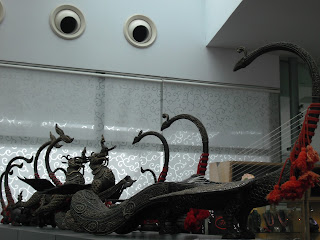Heritage Report By : Gan Yung Chyan
/ KUCINTA SETIA
Distributed to Everyone
The Burmese calendar follows the Jewish calendar, which means the first day of the week is Sunday and the last day of the week or Sabbath is Saturday. This calendar is also shared by the Cambodians, Koreans, Japanese, Chinese, among other races of the world.
The Burmese horoscope differs from the Chinese and Western horoscopes. The Burmese horoscope is defined by animal type and based on days of the week. Below are the representations:-
Sunday : first day: A Burmese born on Sunday is a Rooster in the horoscope.
Monday : second day. A Burmese born on Monday is a Tiger in the horoscope.
Tuesday : third day. A Burmese born on Tuesday is a Lion.
Wednesday : fourth day. This is complicated to decipher. A Burmese believes if one is born in the morning of Wednesday is the royal white Elephant with a pair of yellow tusks. If he is born in the afternoon of a Wednesday (or "Rahu"), he is an ordinary white Elephant with a pair of white tusks in the horoscope.
Thursday : fifth day. A Burmese born on Thursday is a Brown Mouse in the horoscope.
Friday : sixth day. A Burmese born on Friday is a White Mouse in the horoscope.
Saturday : seventh day or Sabbath. A Burmese born on Sabbath is a snake/naga/dragon in the horoscope.
Tourists will notice these queer animal sculptures on display or chinthe for well-wishers at Shwedagon Pagoda.
Myanmar musical instrument saung or Burmese harp is priced worldwide. For instance, it is prized by the Japanese not just for its aesthetic value, but also for its status as the most prestigious instrument in a Myanmar orchestra.
Saungs decorate Burmese restaurants everywhere and are on sale at Yangon International Airport and other major airports of Myanmar. A saung looks like a swan arching its back but its neck can be curved like a monkey's back or the legendary pyinsa rupa as seen above.
Burmese cultures are predominant everywhere in Yangon. You may stick to Yangon without going as far as Mandalay or Bagan to experience Burmese cultures.


No comments:
Post a Comment